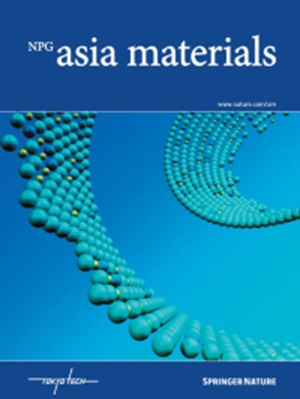Effects of nitrogen vacancy sites of oxynitride support on the catalytic activity for ammonia decomposition
IF 8.3
2区 材料科学
Q1 MATERIALS SCIENCE, MULTIDISCIPLINARY
引用次数: 0
Abstract
Nitrogen-containing compounds such as imides and amides have been reported as efficient materials that promote ammonia decomposition over nonnoble metal catalysts. However, these compounds decompose in an air atmosphere and become inactive, which leads to difficulty in handling. Here, we focused on perovskite oxynitrides as air-stable and efficient supports for ammonia decomposition catalysts. Ni-loaded oxynitrides exhibited 2.5–18 times greater catalytic activity than did the corresponding oxide-supported Ni catalysts, even without noticeable differences in the Ni particle size and surface area of the supports. The catalytic performance of the Ni-loaded oxynitrides is well correlated with the nitrogen desorption temperature during N2 temperature-programmed desorption, which suggests that the lattice nitrogen in the oxynitride support rather than the Ni surface is the active site for ammonia decomposition. Furthermore, NH3 temperature-programmed surface reactions and density functional theory (DFT) calculations revealed that NH3 molecules are preferentially adsorbed on the nitrogen vacancy sites on the support surface rather than on the Ni surface. Thus, the ammonia decomposition reaction is facilitated by a vacancy-mediated reaction mechanism. Oxynitride-supported Ni catalysts exhibit much higher activity than oxide-supported Ni catalysts for ammonia decomposition reaction. Ammonia is activated at nitrogen vacancy sites on the surface of oxynitride in close vicinity to the supported Ni nanoparticles rather than on the Ni surface, and therefore the catalytic performance is dominated by ease of nitrogen vacancy formation on the catalyst surface.

氮化氧载体氮空位对氨分解催化活性的影响
含氮化合物如亚胺和酰胺已被报道为比非贵金属催化剂更有效地促进氨分解的材料。然而,这些化合物在空气中分解并变得无活性,这导致处理困难。在这里,我们重点研究了钙钛矿氮氧化物作为氨分解催化剂的空气稳定和高效支撑。负载Ni的氮氧化物的催化活性比相应的负载Ni的催化剂高2.5-18倍,即使在Ni粒度和载体的表面积上没有明显的差异。在氮气程序升温解吸过程中,负载Ni的氮氧化物的催化性能与氮解吸温度有良好的相关性,这表明氮氧化物载体中的晶格氮是氨分解的活性位点,而不是Ni表面。此外,NH3温度程序表面反应和密度泛函理论(DFT)计算表明,NH3分子优先吸附在载体表面的氮空位上,而不是在Ni表面。因此,氨分解反应是由空位介导的反应机制促进的。氮氧负载的Ni催化剂在氨分解反应中表现出比氧化物负载的Ni催化剂更高的活性。氨在靠近负载Ni纳米颗粒的氮氧化物表面的氮空位位置被激活,而不是在Ni表面,因此催化性能主要取决于催化剂表面氮空位形成的难易程度。
本文章由计算机程序翻译,如有差异,请以英文原文为准。
求助全文
约1分钟内获得全文
求助全文
来源期刊

Npg Asia Materials
MATERIALS SCIENCE, MULTIDISCIPLINARY-
CiteScore
15.40
自引率
1.00%
发文量
87
审稿时长
2 months
期刊介绍:
NPG Asia Materials is an open access, international journal that publishes peer-reviewed review and primary research articles in the field of materials sciences. The journal has a global outlook and reach, with a base in the Asia-Pacific region to reflect the significant and growing output of materials research from this area. The target audience for NPG Asia Materials is scientists and researchers involved in materials research, covering a wide range of disciplines including physical and chemical sciences, biotechnology, and nanotechnology. The journal particularly welcomes high-quality articles from rapidly advancing areas that bridge the gap between materials science and engineering, as well as the classical disciplines of physics, chemistry, and biology. NPG Asia Materials is abstracted/indexed in Journal Citation Reports/Science Edition Web of Knowledge, Google Scholar, Chemical Abstract Services, Scopus, Ulrichsweb (ProQuest), and Scirus.
 求助内容:
求助内容: 应助结果提醒方式:
应助结果提醒方式:


